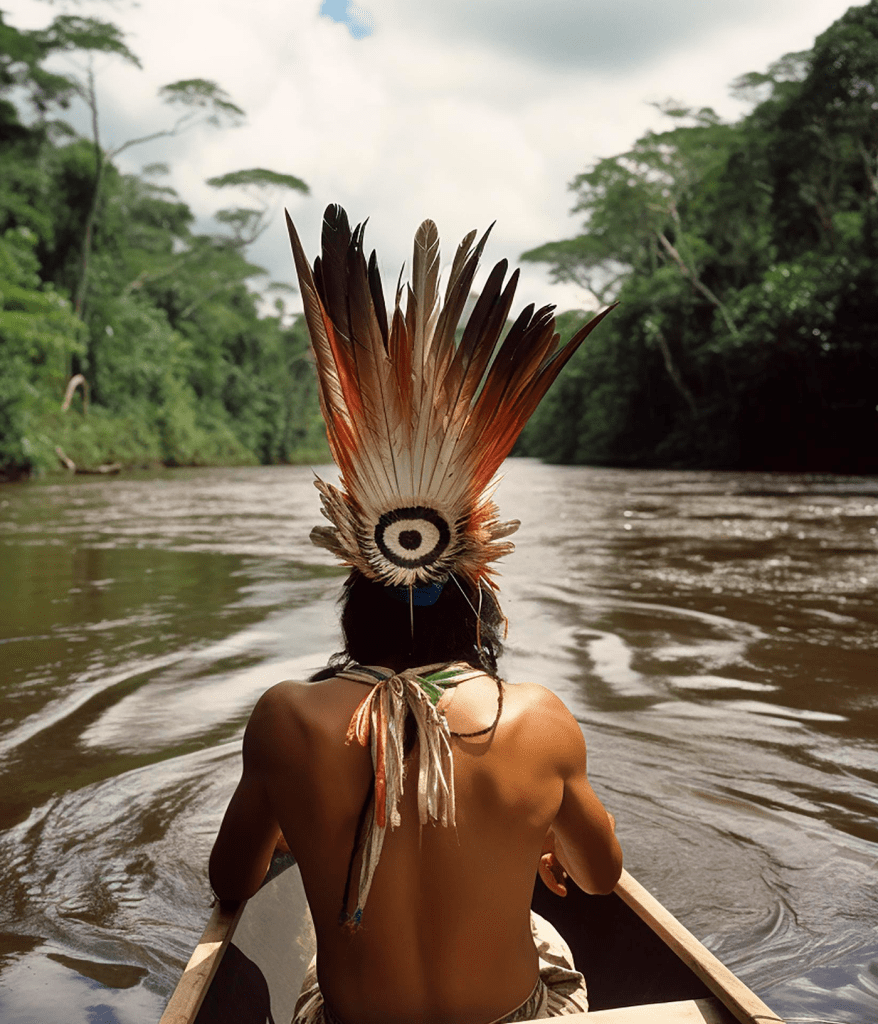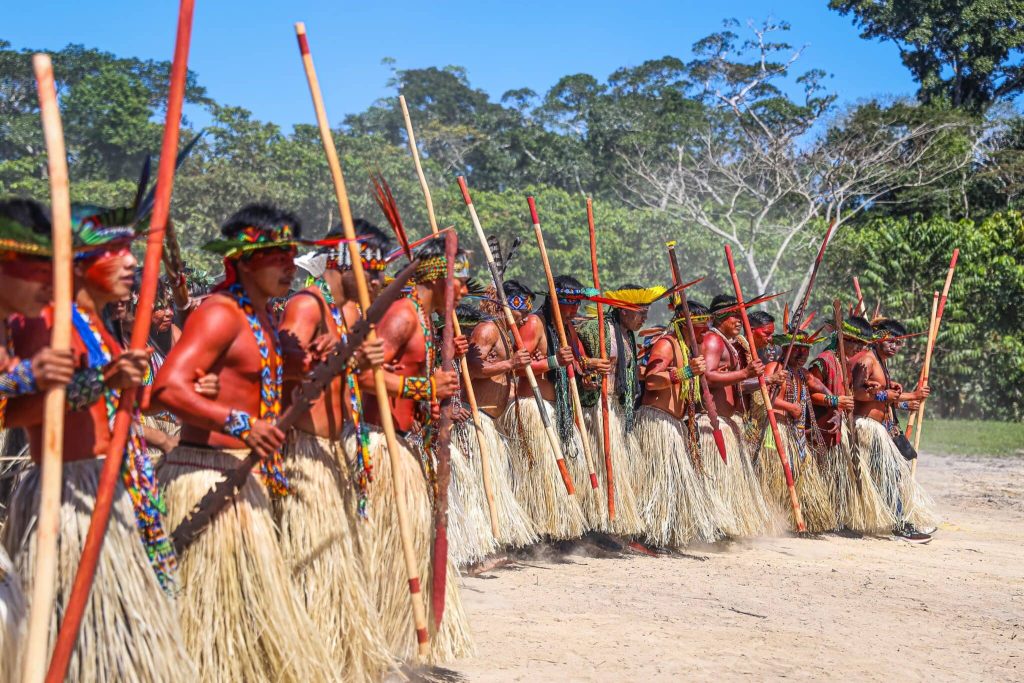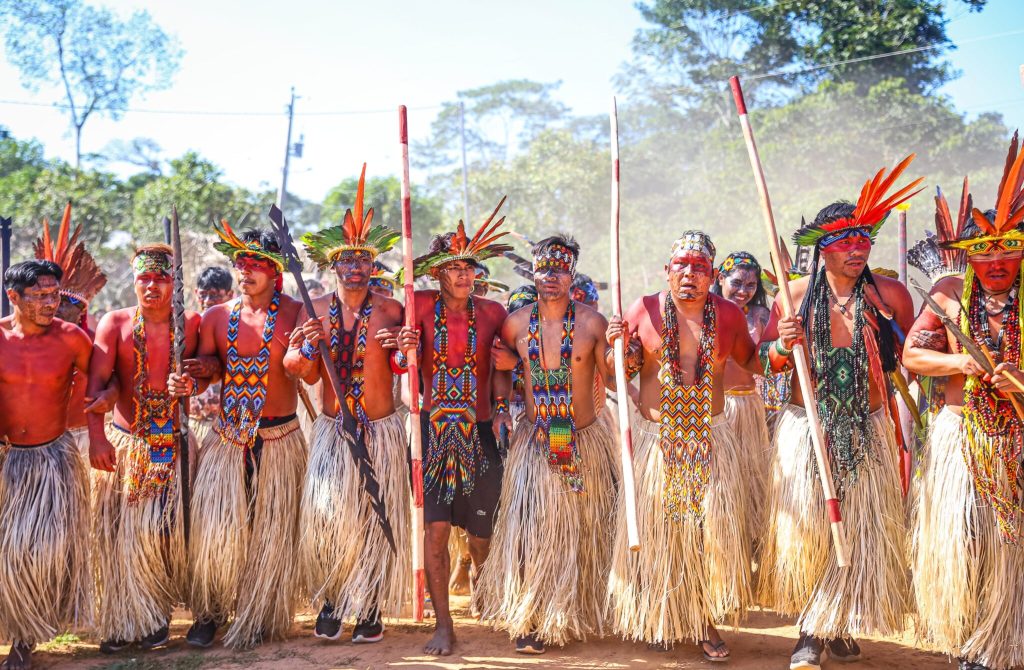Katukina Territory
Like most indigenous communities, the Noke Koi are fighting against Amazonian deforestation, cultural eradication and even their own physical extinction.
The Katukina – as well as other indigenous groups in the upper Juruá region – were surrounded and subjugated when the rubber (Castilloa elastica) and rubber tap (Hevea brasiliensis) boom began in 1880. The region was immediately invaded by Peruvians and Brazilians who came from different places to enrich themselves at the expense of raw materials from the Amazon and the work of the indigenous people.
The Peruvians had a temporary presence, as they searched for rubber in fallen trees, and soon finished off this resource. However, Brazilian rubber tappers, who extracted latex, settled in the area, as they exploited trees by making a vertical cut in their bark, which allowed them to extract rubber for an indefinite period of time.

During these first years of contact, the Katukina moved many times, trying to escape from their exploiters, whose objective was sometimes to annihilate the indigenous populations in order to take over their territories. They dispersed throughout the region, spreading out into the forest, living off of fruit gathering and hunting.
The Katukina saw their territory and population drastically reduced. This population reduction was also helped by the diseases brought by the white man, which they did not know how to cure with their traditional methods. Some submitted to the rubber tappers, being more docile than members of other tribes, and many other families dispersed.
This created a rupture in their society, since they could not organize themselves according to their own traditions. In this coming and going between rivers and rubber plantations, the reference place where the Katukina returned was the Gregório River, with its Siete Estrellas rubber plantation. The changes from one river or one rubber plantation to another are part of the Katukina memory.
In the 1950s, the majority of the Noke Koi people were concentrated in the Siete Estrellas rubber plantation. Ten years later, the Noke Koi people split due to disagreements with their rubber plantation boss on the one hand and with the Yawanawá, a tribe with which they have always had a certain rivalry. Therefore, part of the group decided to look for another place to settle.
In the 1970s, two events occurred that decisively changed the contemporary location of the villages: the opening of the BR-364 highway (which links Rio Branco to Cruzeiro do Sul) and the arrival of the Mission to the New Tribes of Brazil (MNTB) to work alongside the Katukina of the Gregório River.
With the construction of the BR-364 highway, during Lula’s first government, part of the group that had settled near the mouth of the Riozinho da Liberdade was forced to move and even work in deforestation for the construction of the road. Others were also displaced from the Gregório River.

After the construction was completed, the Katukina were allowed to settle on the side of the road, which the central government considered a good place due to its proximity to the city of Cruzeiro do Sul.
There they hoped to easily sell their crafts and obtain the industrial goods they needed. Some saw in the missionaries a possibility of regular medical and educational assistance, so they did not rebel against the abandonment of their culture and traditions.
Beginning in the mid-1980s, after many years of wandering and moving, the Katukina saw their right to own the territory they inhabited recognized and broke the ties that bound them to their bosses who exploited the rubber plantations.
This was thanks to the uprising of other tribes, such as the Yawanawá, who resisted being enslaved by the rubber tappers and subjugated by the missionaries. They obtained national rights over their territories and those of all the indigenous peoples of the Amazon.
Throughout history, the Katukina have maintained contact (sometimes peaceful, sometimes not) with various indigenous groups from the Juruá River region and, more recently, also with groups from the Javarí River region. The Kulina, the Yawanawá and the Marúbo are the three groups with which contacts were and are most intense and significant for the Katukina.
Contacts between the Katukina and the Kulina (speakers of an Arawa language and currently living in scattered villages along the Juruá and Purus rivers in Brazil and Peru) were frequent, at least until the 1960s. Members of the two groups had the custom of meeting to perform rituals.
Today, the Katukina and the Kolina have stopped meeting, due to the successive relocations of the Kolina, the two groups live far apart from each other.
The Katukina still remember the chants that the Kolina taught them, which were incorporated into the Katukina musical repertoire and which they still sing today, even though they do not understand their meaning.
Of the Pano linguistic groups in the upper Juruá region, the Yawanawá tribe are the Katukina’s closest and oldest neighbours, and currently share the Gregório River Indigenous Land with them.
The Yawanawá have always been the Noke Koi’s most assiduous adversaries, who accuse them of having kidnapped their women and unleashed war. Accusations of witchcraft are also common, and persist to this day.
In the 1980s, the Noke Koi and the Yawanawá joined together to claim the joint demarcation of their lands. Since then, their relations have improved and they perform some rituals together, interethnic marriages take place and co-residence exists.
Although a little further away, the Marúbo have also maintained regular contacts with the Katukina that began not many years ago. They also share the names that divide their clans: Varinawa (people of the Sun), Kamanawa (people of the Jaguar), Satanawa (people of the Otter), Waninawa (people of the chontaduro), Nainawa (people of the Sky), Numanawa (people of the dove).
The first meeting between these two ethnic groups seems to have occurred around 1980, when missionaries brought two members of the Noke Koi tribe, inhabitants of the Gregório River, to meet the Marúbo.

In 1992, after a chance encounter at the port of the city of Cruzeiro do Sul, the Katukina were walking along the port when they heard some people speaking a language similar to their own and decided to approach them. They discovered that they had many characteristics in common, such as the names of their clans. They exchanged gifts and began to visit each other in their different villages.
After these visits, the Katukina began to reflect on the similarities they had with the Marúbo, concluding that in the past, the Marúbo must have formed a single group with the Katukina, having divided before the first contact with the whites.
Their similarities keep both tribes allied: the Marúbo language is similar to the Katukina language; the communal houses in which the Marúbo live are very similar to the houses in which the Katukina lived before establishing contact with the whites. According to the Katukina, the Marúbo preserve a way of life that must have been part of their customs and traditions in the past.
